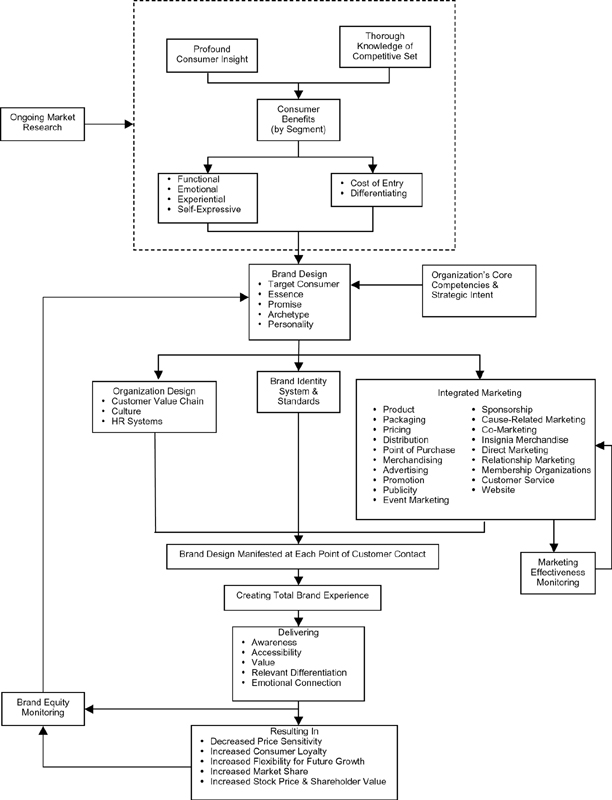3
brand management process: an overview
The brand management process starts with a deep understanding of consumers and competitors. You need to fully understand the consumer benefit structure by segment, including which benefits are cost of entry and which are differentiating. In-depth qualitative consumer research will help uncover this information. You will also need to know which benefits each of your competitors delivers in consumers’ minds. Ultimately, you will need to know which benefits are important, personally relevant, unique and differentiating, purchase motivating, and appropriate for your brand. You also need to know that consumer benefits can be functional, emotional, experiential, or self-expressive. Once you acquire all this knowledge, you can begin to design your brand.
Designing Your Brand
In brand positioning or design, there are five components to be addressed:
1. Target Audience. Define the target customer.
2. Brand Essence. Articulate the “heart and soul” of the brand.
3. Brand Promise. Develop the relevant, differentiating benefits the brand promises to deliver to its target audience.
4. Brand Archetype. Identify the driving motivation behind the brand.
5. Brand Personality. Describe the brand as if it were a person.
As you address these five components (especially brand promise) you need to define your brand’s competitive frame of reference and map out how it is positioned against competitors. (Figure 3–1 is a brand positioning statement.)
Figure 3–1. Brand positioning statement of The Nature Conservancy.
The Nature Conservancy
Target Audience:
1. Affluent people who are concerned about environmental conservation
2. Opinion leaders
Brand Essence:
Saving Great Places
Brand Promise:
Only The Nature Conservancy works in creative partnership with local communities in the U.S. and abroad to conserve the most important natural places for the benefit of future generations.
Brand Archetypes:
Scientist, advocate, and achiever
Brand Personality:
• Results-oriented, action-oriented
• Effective
• Entrepreneurial
• Focused
• A good ally, a reliable partner
• Possessing integrity
• Businesslike, professional
• Hardworking, persistent, tireless, dedicated
• Positive, constructive, nonconfrontational
• Science-driven
Although this may sound like a linear process, it is actually iterative and even organic. In the end, though, you will have determined each of the elements of your brand’s design.
Figure 3–2 provides an overview of the brand management process.
Once the brand is designed, this design must drive all your consumer communication, all your other marketing elements, and your organization’s design, particularly the company culture. It must also drive what Michael Porter, Harvard Business School professor and thought leader, calls the “customer value chain.” (According to the “value chain” concept, each activity an organization undertakes should lead to added value to its target consumers. If it doesn’t, it should be reevaluated and possibly eliminated.1)
The brand design should be directly translated into and supported by the brand identity standards and systems. This process ensures that the brand design is realized at each point of contact with the consumer, resulting in a total brand experience. If done right, a brand and the experience it delivers transcend the brand’s products and services. In essence, you are selling the brand experience more than anything else.
All of this should deliver awareness, relevant differentiation, value, accessibility, and emotional connection—the key components in creating brand insistence.
Ultimately, strong brand equity should result in price premiums, decreased price sensitivity, increased consumer loyalty, increased flexibility for future growth, increased market share, and increased shareholder value.
THE MOST IMPORTANT TASKS OF A BRAND MANAGEMENT FUNCTION
• Develop and execute brand plans, including brand marketing plans.
• Build brand awareness.
• Position the brand for sustainable competitive advantage.
• Transform the organization’s leadership team into brand champions.
• Transform all employees into brand champions.
• Measure and actively manage your brand’s equity.
• Actively manage the brand’s identity, including enforcement of its guidelines and standards.
• Legally protect the brand.
• Always keep the brand customer-focused.
• Design and implement plans to create emotional connection between your brand and its customers.
• Develop and execute brand loyalty programs.
Research That Supports the Brand Management Process
There are many types of research that aid in the brand management process. Some are ongoing, while others are only conducted periodically or as needed. Ongoing research includes brand equity, marketing effectiveness, and competitive monitoring, among other categories of research.
MONITORING BRAND EQUITY
Brand equity monitoring should highlight changes in consumers’ attitudes, preferences, and behavior regarding your brand. It should also play a diagnostic role, giving insight into the whys those changes occur. While some brands, such as Coca-Cola, monitor brand equity on an ongoing basis, many brands conduct a more comprehensive brand equity “snapshot” every year or two.
MONITORING MARKETING EFFECTIVENESS
Marketing effectiveness monitoring takes many forms—from simple testing of advertising copy to using an ongoing system to identify the relative effectiveness of each element in your marketing mix, including estimates of return on marketing investment. It can be even more detailed, including analysis of effectiveness against different marketing objectives, such as customer retention, share of requirements, category buying rate, in-store capture, and conversion rates.
COMPETITIVE MONITORING
Competitive monitoring can take many forms, from dialy panel studies and market tours to product preference testing and POS (point of sale) data analysis—chain-specific data or from ACNielsen (Scan Track) or IRI (DataServer, FasTrac, and InfoScan).
Onetime or periodic research includes attitude and usage studies, in-depth qualitative consumer research, focus groups, conjoint analysis, Perception Analyzer testing, recognition and recall tests, concept testing, benefit testing, and test markets.
BRAND EXTENSION RESEARCH
A brand is an asset, and to provide strong shareholder value, assets must be leveraged. Brand extension is the primary way of doing that. Brand extension can be a powerful way to optimize the performance of your brand, but it also can be a complicated endeavor. Brand extension and brand extension research are discussed in detail in Chapters 15 and 17.
BRAND MANAGER COMPETENCIES AND RESPONSIBILITIES
Brand Manager Competencies
• Strong ability to influence behaviors and perceptions without formal authority
• Respected throughout the organization
• Strong written and verbal persuasion skills
• Adequate analytical skills
• Customer research experience
• Strong intuition about human behavior and motivation
• Good project management skills
Brand Manager Responsibilities
• Identify, refine the brand’s “unique value proposition.”
• Monitor, measure, and manage brand equity/strength.
• Increase brand awareness, relevant differentiation, value, accessibility, and emotional connection.
• Develop brand plan.
• Monitor progress against brand plan.
• Be responsible for results against brand plan.
• Drive brand understanding and support organization-wide.
• Champion/drive initiatives that support delivery of the brand promise.
• Develop brand messaging—elevator speech, tagline, campaign themes, proof points, etc.
Brand Identity Manager Competencies
• Strong ability to influence behaviors and perceptions without formal authority.
• Respected throughout the organization.
• Likable.
• Assertive.
• Ability to say “no” in a nice way.
• Some understanding of brand identity standards and systems.
Brand Identity Manager Responsibilities
• Manage the brand architecture.
• Establish brand architecture and naming decision rules.
• Establish brand identity standards including cobranding standards.
• Maintain brand identity consistency.
• Chair the brand identity council/team/board.
• Help manage brand identity transitions resulting from mergers and acquisitions.
• Help determine identities for new brands/subbrands.
• Anticipate and accommodate new brand identity needs.

